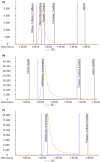Effect of hot smoking treatment in improving Sensory and Physicochemical Properties of processed Japanese Spanish Mackerel Scomberomorus niphonius
- PMID: 32724656
- PMCID: PMC7382142
- DOI: 10.1002/fsn3.1715
Effect of hot smoking treatment in improving Sensory and Physicochemical Properties of processed Japanese Spanish Mackerel Scomberomorus niphonius
Abstract
Japanese Spanish Mackerel (JSM) Scomberomorus niphonius (Cuvier 1832) is an important commercial fish species in South Korea. The postharvest handling, preservation, and storage of JSM have not been clearly understood, and therefore, it is very often oxidized to produce off-flavor while marketed as the raw or frozen state. To overcome these problems, the present study was designed to adapt the hot smoke processing technique for improving the sensorial, physicochemical, and microbial qualities of JSM with extended shelf life. The hot smoking (70°C) with different sawdusts at the different smoke times (0, 20, 25, and 30 min) was applied to process JSM fillet. The smoked JSM obtained higher sensory attributes (appearance, odor, taste, color, texture, and overall preferences) and suppressed bacterial growth, pH, volatile base nitrogen, thiobarbituric acid-reactive species, and trimethylamine N-oxide at an optimum smoking time of 25 min using oak sawdust. Moreover, it possessed higher nutritional value and beneficial polyunsaturated fatty acids such as docosahexaenoic acid (DHA), 4.19 g/100 g, and eicosapentaenoic acid (EPA), 1.82 g/100 g. The smoked JSM product extended shelf life up to 42 days at 10°C storage temperature. The overall findings indicate that the hot smoking technology with JSM could be effective in achieving good sensorial, nutritional, and functional attributes to the consumer.
Keywords: Japanese Spanish Mackerel; hot smoking; physicochemical properties; processing and preservation; sensory evaluation.
© 2020 The Authors. Food Science & Nutrition published by Wiley Periodicals LLC.
Conflict of interest statement
The authors declare no conflict of interest.
Figures






References
-
- Adeyeye, S. A. O. (2019). Smoking of fish: A critical review. Journal of Culinary Science & Technology, 17(6), 559–575. 10.1080/15428052.2018.1495590 - DOI
-
- Ahmed, E. O. , Ali, M. E. , Kalid, R. A. , Taha, H. M. , & Mahammed, A. A. (2010). Investigating the quality changes of raw and hot smoked Oreochromis niloticus and Clarias lazera. Pakistan Journal of Nutrition, 9(5), 481–484. 10.3923/pjn.2010.481.484 - DOI
-
- Alasalvar, C. , Miyashita, K. , Shahidi, F. , Wanasundara, U. (Eds.). (2011). Handbook of seafood quality, safety and health applications. John Wiley & Sons.
-
- Ali, M. Y. , Hossain, S. Z. , Rashed, M. A. , Khanom, M. , & Sarower, M. G. (2013). Protein loss due to post‐harvest handling of shrimp (Penaeus monodon) in the value chain of Khulna region in Bangladesh. International Journal of Engineering, 3(1), 2305–8269.
-
- AOAC (2000). Official methods of analysis, William Horwitz, Ed. Washington, DC.
LinkOut - more resources
Full Text Sources
Research Materials

